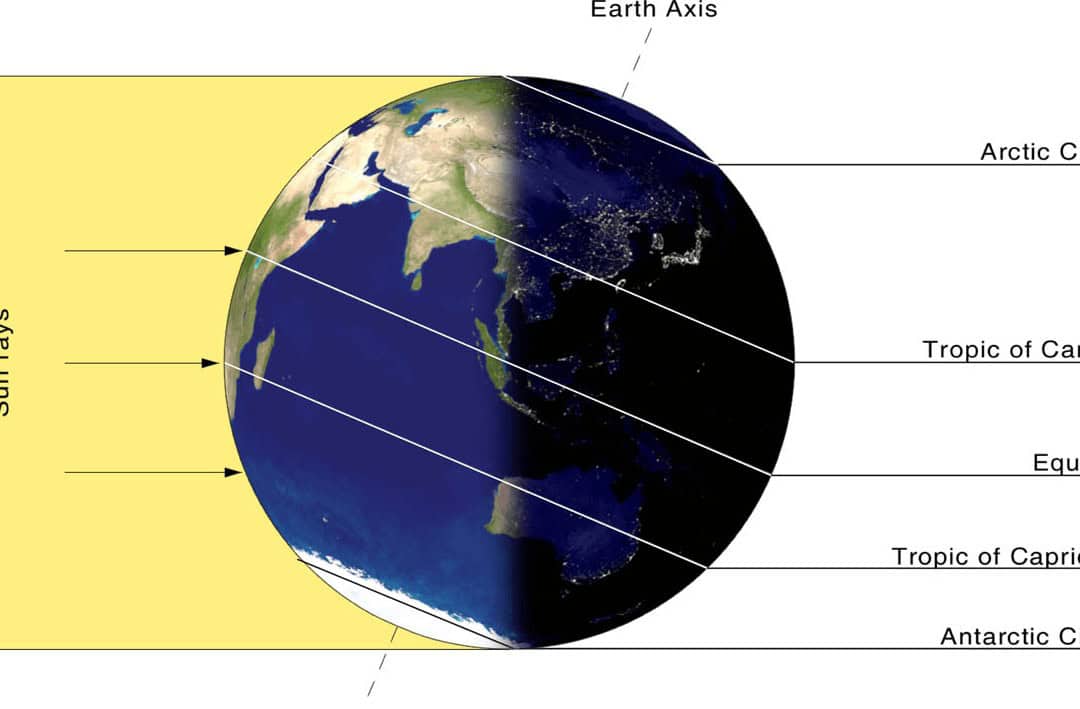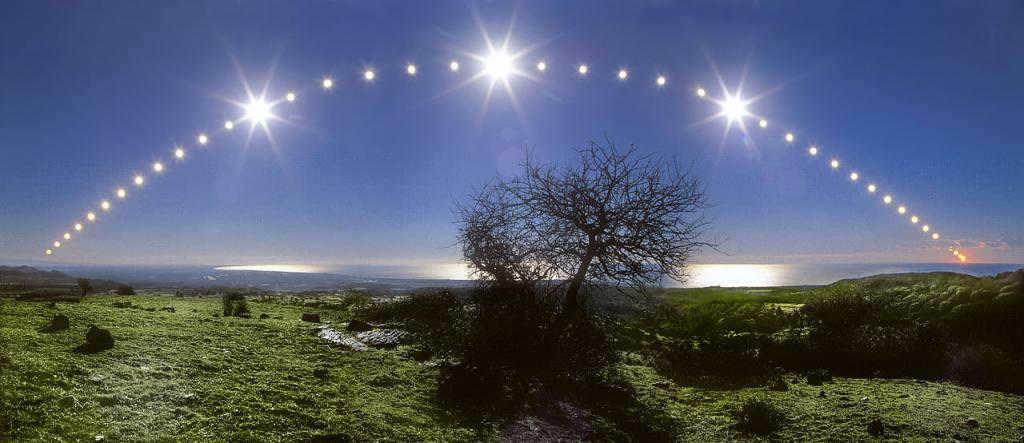
Frequently, you hear the phrase “the sun is at its highest point”. What is the significance of this statement? Where can you currently observe the celestial body in the sky, and how is this location distinct from its other positions and conditions? When during the day or year does this phenomenon take place? And, if the sun is at its zenith – what implications does this have for the people inhabiting planet Earth?
Essential details regarding the Sun
The Sun serves as the nearest star to our planet, Earth. It functions as the central celestial body within the solar system. This celestial entity takes on a spherical shape and comprises luminous gases. Its surface temperature reaches approximately 5505 ° C, while the central region experiences heat of up to 13.5 million degrees.
With a diameter measuring nearly 1,392,000 kilometers, the Sun surpasses the size of Earth by a factor of approximately 110.

Around the Sun, there exists an atmosphere that consists of three layers – the photosphere, the chromosphere, and the solar corona. The first layer, the photosphere, is where all the radiation that can be perceived by the human eye belongs. During a total solar eclipse, it becomes possible to observe the solar corona, which has a diameter many times larger than its source.
The mass of the Sun surpasses that of the Earth by 333 thousand times, and its volume is even greater – 1 million 304 thousand times, resulting in a lower density of the star’s composition.
The energy that our planet receives from the Sun is only a small fraction of the total energy emitted by the star, yet it is significantly greater than all the energy artificially produced on Earth.
The rotation of the sun on its axis takes place in 25.4 of our standard twenty-four-hour days.
The approximate distance from our planet to the Sun is 149.5 million kilometers, but these values are so vast in terms of magnitude that they are quantified not in linear units, but in terms of the time it takes for light to travel. It takes 8 minutes and 18 seconds for sunlight to reach the Earth (traveling at a speed of 300,000 kilometers per second).
The entire solar system is in constant motion through space towards the Lyra constellation. The velocity of this movement is 20 kilometers per second.
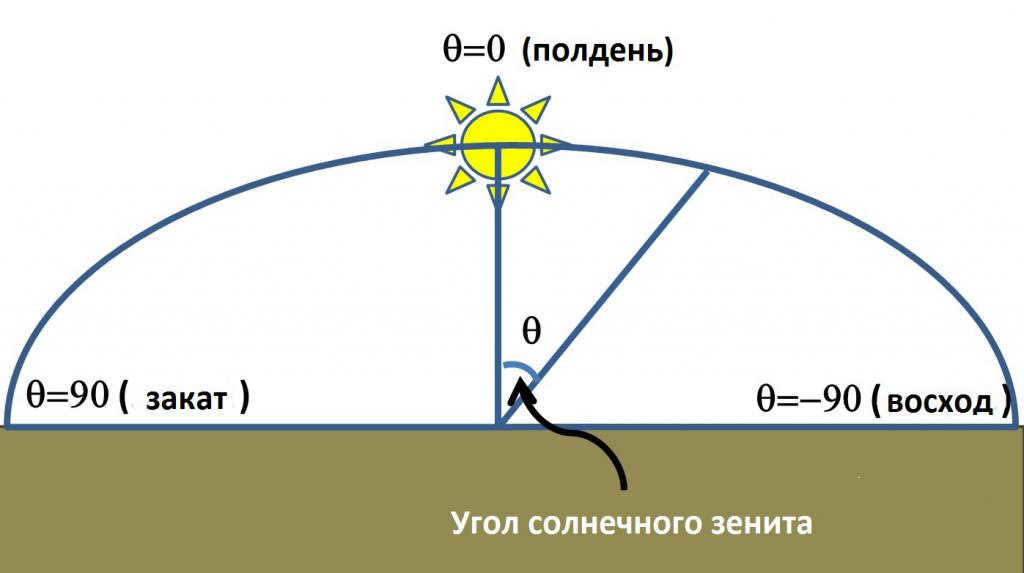
Zenith is the highest point in the sky, meaning that when the sun is said to be at the zenith, it is directly overhead. At this point, the sun’s rays are perpendicular to the Earth’s surface, creating right angles. So, if objects do not cast shadows, it indicates that the sun is at its zenith.
However, colloquially, the term “zenith” is used to describe the position of the sun, which is only approximately at the zenith. Due to the specificities of celestial bodies and their positions in outer space, the sun’s rays will not fall at a 90-degree angle on every part of the Earth.
The nadir is a point directly opposite the zenith, below the horizon line, on the same vertical line.
Variation in the position of the Sun’s highest point throughout the year

Due to the constant movement of celestial bodies in relation to each other and their own rotation, the position of the sun’s zenith changes throughout the year. It moves from tropic to tropic at an approximately rate of 1° every four days (or more precisely, 3.8 days), which is equivalent to 2° per week. This means that it is relatively easy to determine how the sun’s zenith will shift in relation to the Earth.
By knowing the dates of the solstices, you can make a rough calculation of the latitude at which the sun will be directly overhead on any given date.
Twice annually, the Sun reaches its highest point directly above the equator – on March 21st and September 23rd, during the days known as the autumn and vernal equinox, when the duration of light and darkness are equal. These specific dates serve as the reference points for determining the latitude of the Sun’s position in the zenith.
As an example, when calculating the latitude at which the sun will be on the Russian Day of Cosmonautics – April 12th, it is necessary to determine the number of days that have passed since the nearest reference date (which is the vernal equinox on March 21st). There are 22 calendar days between the reference point in time and the calculated date. If the luminary’s position changes by 1° every 3.8 days, then for 22 days its location will change by 22 : 3.8 = 5.7°. Since precise calculations are not required in this case, the resulting value can be rounded to 6°. This represents the angle at which the Sun’s position in relation to the Earth, in the direction of its movement north of the equator, will change.

For the purpose of determining the points and positions of objects on the planet’s scale, the entire Earth is divided into horizontal and vertical lines known as parallels and meridians, respectively. The longest among these circumferential lines is the equator, which lies in the middle. When referring to the position of a certain point on the planet using parallels, the term “latitude” is employed.
The vertical lines, on the other hand, are referred to as meridians and correspond to longitude. The numerical values of latitude and longitude are expressed in degrees.
Due to the Earth’s shape and its axis being tilted at an angle of 23 degrees relative to the Sun, it is not possible for every point to experience the phenomenon of the luminary’s position in the zenith. This occurrence remains inaccessible for most individuals.
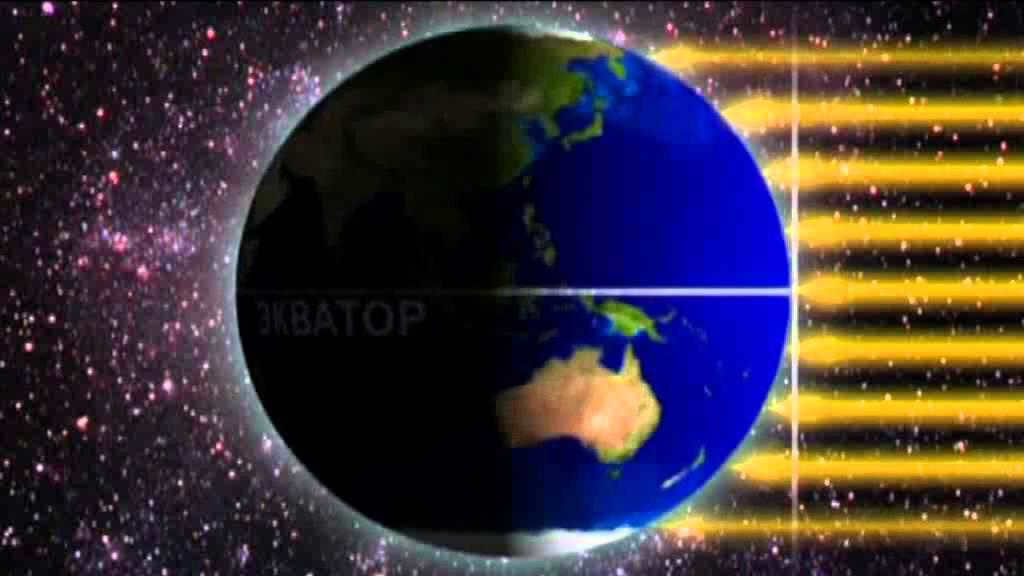
The angle of incidence of the sun’s rays is perpendicular only at the equator and within the tropical regions, which are located between the lines above and below (to the north and south) of the equator.
The Northern Tropic (named after the Cancer constellation) and the Southern Tropic (named after Capricorn) define the regions of the planet where the sun’s position at zenith can be observed at noon.
During the summer solstice on June 22, the sun will be at zenith over the parallel known as the Northern Tropic, while during the winter solstice on December 21, it will be at zenith over the Southern Tropic. In the areas between these latitudes, the zenith position of the sun can be observed twice a year.
How the sun’s zenith sparks creativity in poets
The ethereal celestial bodies, whether they reign in the day or prevail at night, serve as a wellspring of inspiration for artists who seek to capture their essence through various art forms such as paintings, music, and literature.
Among these creative souls is Kira Tikhonova (formerly known as Danilyants), a talented young poetess from Moscow who was honored as a laureate at the Pushkin Youth Festival “On a par with the century”.
Sun at its peak
The sun is at the peak of its trajectory, my coat is resting on the snowy ground.
Dragging a sled up the street,
A sled that feels as heavy as solid iron,
With shiny skids.
And amidst the laughter and screams of the crowd.
I am descending rapidly,
♪ Into a heap of excited faces ♪
♪ Glowing with frost ♪
Snow covering the ground, it’s a children’s celebration!
We have built forts
We have spent the entire day outdoors
With our clothes thoroughly soaked.
We are engaged in a snowball fight
We return home in the darkness
♪ As hot as a sauna ♪
We are exhausted and hang our clothes to dry!
The sun is at its zenith, our shorts are covered in dust.
In a pile of joyful children
Rust stains on the handlebars
An old bicycle is ridden
My knees are once again green and bruised.
The sun feels like it’s in the tropics – thirty-five degrees!
We are delighted to chase and catch up
In this scorching sun
No iPad, no tablet,
# Ten years before the advent of computers
A childhood filled with joy and brightness
Recalled amidst a misty remembrance
The sun shining at its highest peak. Overalls.
My eldest child wearing a frown
♪ The snow playfully tickling the tip ♪
Of a fresh pair of shoes.
Victoria Vikolskaya, a budding writer hailing from the town of Mytishchi near Moscow.
Sun at its zenith
I adore those crystal-clear days,
When the sun reaches its highest point.
And in the morning, it reaches the zenith,
And in the evening, it reaches the zenith
And not just at noon
Even if it’s gloomy outside
Even if it’s chilly
The sun invites you to take a stroll
Because it’s at its zenith
♪ The sun’s rays illuminate the world in the morning ♪
# It’s quite common
But there’s something exceptional about it.
And what’s exceptional?
Today is today, yesterday was yesterday
What’s peculiar is what’s peculiar
What the sun doesn’t care about
What time it is across the globe
Let it be any time around the world
♪ The sun’s rays brighten the world in the morning ♪
I adore those crystal-clear days
When the sun is at its zenith
What does it signify when the sun is at its zenith?
It means there are no clouds in the sky,
♪ In the morning, there are no clouds in the sky ♪
And in the evening, there are no clouds in the sky.
A beam illuminating a glass.
A beam on a leaf of a tree.
Or on lofty, majestic summits
A beam of sunshine.
Even if the clouds are scowling
If there’s a single beam of sunshine
It means the days are not overcast.
And if the days are not overcast
♪ No matter how faint that beam may be ♪
It’s mightier than the clouds!
Because it broke through the clouds,
Presented by the powerful sun
♪ If a beam breaks through the clouds ♪
It’s not a cloudy day,
If there’s a single beam
Then the sun is at its zenith!
While it may not be scientifically accurate, the weather is pleasantly warm and incredibly sunny.
The sun as a symbol when it is at its highest point in the sky

In every doctrine that relies on symbolism, the sun holds a special position. When it comes to the sun as a symbol that influences the interpretation of dreams, you can find various explanations in different collections.
If you had a dream about the sun being in the zenith – what does it mean, and how should you interpret such a vision? Here are several possible interpretations of this dream:
- Fulfilled ambitions and the realization of all (or limitless) possibilities for the dreamer;
- Successful choices of admirers and the successful execution of a meticulously planned path towards personal prosperity;
- Happiness and a well-deserved sense of accomplishment;
- Career advancement;
- Good luck in all aspects of life.
From my early years, I observed the Sun’s varying path across the sky, which differed depending on the season. As I grew older, I discovered that the Sun travels along distinct parallels, each with its unique name. One such parallel, known as the Northern Tropic or the Tropic of Cancer, marks the point where the Sun reaches its highest point on June 22.

About the parallel known as the Northern Tropic
This particular date and designation were not chosen randomly. June 22nd marks the occasion of the summer solstice, when the Sun reaches its highest point in the sky in the Northern Hemisphere. At noon on this day, the angle at which the Sun’s rays strike the Earth’s surface in the Northern Hemisphere reaches its maximum value. It is this characteristic that led to the naming of this parallel as the Northern Tropic.
It should be noted that the location of the Northern Tropic cannot be considered fixed, as it is primarily determined by the tilt of the axis around which our planet rotates in relation to the Sun. Additionally, the position of the tropics gradually shifts due to nutation (“wobbling”) and other cycles in the Earth’s movement.
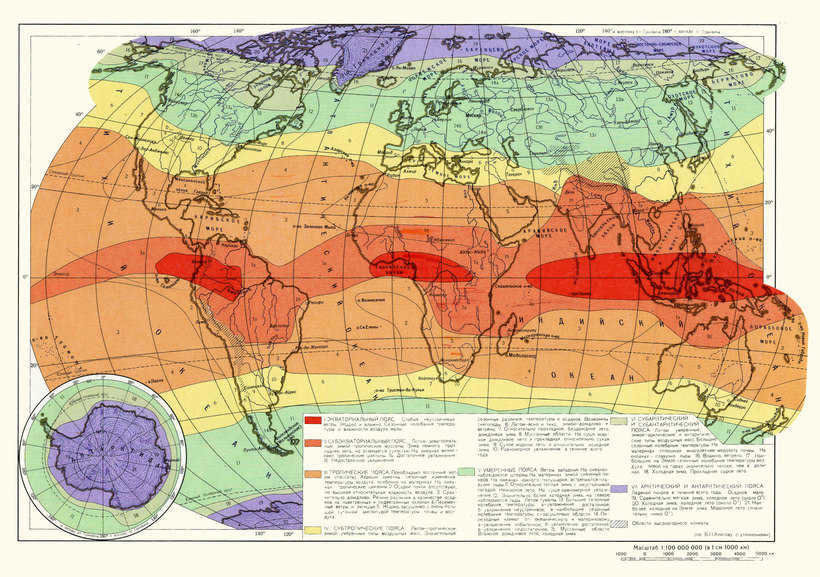
Countries crossed by the Tropic of Cancer
If you are interested in visiting the location where the Tropic of Cancer passes, you have the option to explore one of the following countries:
There are a total of 14 countries that the Tropic of Cancer crosses. However, not all of them are popular tourist destinations today, such as Myanmar or Libya.
June 22nd, a day when the Sun reaches its highest point over the Northern Tropic, is often regarded as a remarkable day. This is why many occultists and pagans observe their religious festivals, bidding farewell to the sun as it begins its decline.
Sailors have an intriguing custom: whenever a ship crosses the Tropic of Cancer, they partake in the celebration of Neptune’s feast, regardless of the specific date on the calendar.

There is also the Southern Tropic, which the Sun crosses around December 21-22. This marks the shortest day in the Northern Hemisphere, indicating that the nights will begin to get shorter from this point onward.
On a scorching summer day, when the skies are clear and we are exhausted from the sweltering heat, we often hear the phrase “the sun is at its zenith”. In our understanding, it means that the sun is at its highest point and is heating up the earth to the maximum. Let’s delve a bit into astronomy and explore more about this expression and the accuracy of our understanding.

Earth’s parallels
From our early school days, we have been taught about the existence of parallels on our planet. These parallels are invisible lines that are determined by basic principles of geometry and physics. Understanding the significance and origin of these parallels is crucial for comprehending the field of geography. There are three primary lines that are commonly distinguished – the equator, the Arctic Circle, and the tropics.
Equator
The equator is an imaginary line that runs around the Earth at its center, dividing it into two equal halves, the northern hemisphere and the southern hemisphere. It is located at 0 degrees latitude and is the longest line of latitude on the Earth’s surface. The equator is important because it is the starting point for measuring latitude and is used as a reference point for navigation and mapping. It also plays a role in determining the Earth’s climate and weather patterns. The equator is known for its warm temperatures and lush vegetation, and it is home to a diverse range of plant and animal species. Overall, the equator is a significant feature of the Earth’s geography and has a major impact on the planet’s ecosystems and climate.
The equator is commonly referred to as an invisible (conventional) line that divides our Earth into two identical hemispheres – the Northern and Southern hemispheres. It has long been known that the Earth is not supported by three pillars, as believed in ancient times, but rather has a spherical shape and rotates on its axis in addition to orbiting the Sun. This means that the equator, which stretches for approximately 40,000 kilometers, is the longest parallel on the Earth. From a mathematical perspective, this is clear, but what does it mean for geography? Upon closer examination, it becomes apparent that the region between the tropics receives the most solar heat and light. This is because this area of the Earth is always facing the Sun, resulting in the rays falling almost perpendicular to the surface. As a result, the equatorial regions experience the highest air temperatures, and the moisture-laden air masses lead to significant evaporation. The Sun reaches its zenith at the equator twice a year, shining directly downward. This phenomenon, for example, never occurs in Russia.

Tropics
The Earth is divided into two main tropics: the Southern Tropic and the Northern Tropic. It is interesting to note that the sun reaches its highest point in the sky only once a year, which happens on the solstice. On December 22, known as the winter solstice, the Southern Hemisphere is tilted towards the Sun, while on June 22, the Northern Hemisphere is tilted towards the Sun.
These tropics are sometimes referred to by the zodiacal constellation that is in the Sun’s path on these specific days. Therefore, the Southern Tropic is commonly known as the Tropic of Capricorn, and the Northern Tropic is called the Tropic of Cancer, corresponding to December and June respectively.
Polar Circles
The polar circle is the latitude above which the phenomenon of polar night or day occurs. The position of the polar circles is determined mathematically, being 90 degrees minus the tilt of the planet’s axis. For Earth, the value of the polar circles is 66.5 degrees. Unfortunately, people living in temperate latitudes are unable to witness these phenomena. However, the occurrence of the sun at the zenith on the latitude corresponding to the polar circle is completely natural.
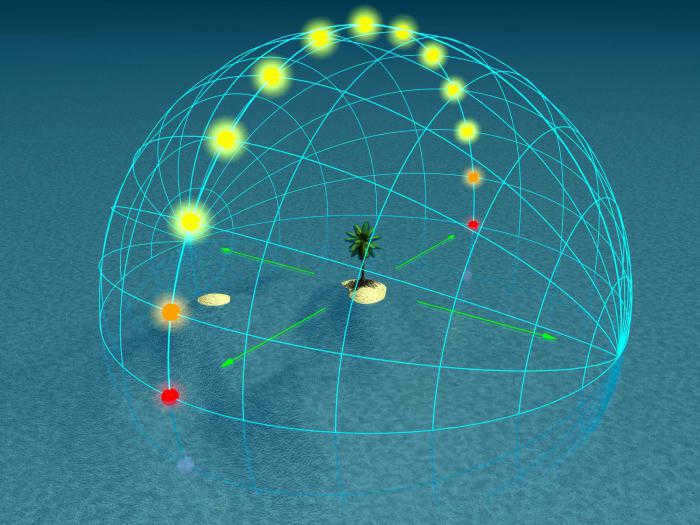

General knowledge
It is a well-known fact that the Earth is in constant motion. Not only does it revolve around the Sun, but it also rotates on its axis every 24 hours. As the seasons change, we observe variations in the length of the day, the temperature, and even the shifting positions of the stars in the sky. Over the course of 364 days, the Earth completes a full orbit around the Sun.
Day and Night
When we experience darkness, which we refer to as night, it signifies that during a certain period of time, the Sun is illuminating the opposite hemisphere. An obvious question arises: why is the duration of day not the same as the duration of night? The reason lies in the fact that the plane of the Sun’s path is not perpendicular to the Earth’s axis. If it were, we would not have the seasons, during which the ratio between the duration of daylight and darkness varies.
On the 20th of March, the North Pole starts to lean towards the Sun. Then, around noon on the equator, we can confidently say that the sun is directly overhead. This is followed by similar occurrences at more northern locations. By June 22, the sun is directly overhead on the Tropic of Cancer, marking the middle of summer and the longest day in the northern hemisphere. This event is commonly known as the solstice.
What’s interesting is that everything repeats in reverse order after this day, continuing until September 23 when the sun is once again directly overhead at noon on the equator. This marks the start of midsummer in the southern hemisphere.

Therefore, it can be inferred that when the sun reaches its highest point at the equator, the length of the night on Earth is 12 hours, which is the same duration as the day. This occurrence is commonly referred to as the autumn or vernal equinox.
Although we have already clarified the accurate definition of the term “sun at zenith,” we still find it more familiar to use a phrase that indicates the sun being at its highest point on that specific day.
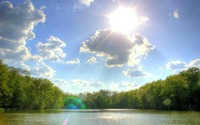
As a young child, I observed that the position of the Sun in the sky varied depending on the season. Later on, I discovered that the Sun follows different paths along various parallels. These parallels are named, with one example being the Northern Tropic, also known as the Tropic of Cancer, where the Sun is directly overhead on June 22.
An Overview of the Northern Tropic Parallel
The Northern Tropic parallel, also known as the Tropic of Cancer, is an imaginary line that circles the Earth at approximately 23.5 degrees north latitude. This parallel is of great significance in terms of climate and celestial observations.
The Northern Tropic parallel marks the northernmost point where the sun can appear directly overhead at noon on the summer solstice, which usually occurs around June 21st. This phenomenon, known as the Tropic of Cancer, is a significant event for those living in the tropics, as it signifies the beginning of summer and the longest day of the year.
In addition to its role in determining the changing seasons, the Northern Tropic parallel also plays a crucial role in celestial observations. As this parallel is located near the equator, it provides an ideal vantage point for observing astronomical events such as eclipses and the movement of celestial bodies.
The Northern Tropic parallel passes through several countries, including Mexico, Saudi Arabia, India, and China. These regions are known for their warm climates and lush vegetation, which are a result of the sun’s direct rays at this latitude.
Overall, the Northern Tropic parallel is an important geographical and astronomical feature that has a significant impact on climate and celestial observations. Its position on the Earth’s surface makes it a unique and fascinating aspect of our planet’s natural environment.
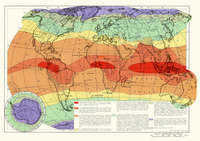
This specific date and name were intentionally chosen. The reason being that June 22 marks the summer solstice, which is the day when the Sun reaches its highest point in the Northern Hemisphere. At this time, the Sun is positioned at the most northerly latitude where it can ascend to the zenith. During noon, the angle at which the Sun’s rays hit the Earth’s surface in the Northern Hemisphere reaches its maximum value. This is precisely why the parallel is referred to as the Northern Tropic.
It’s important to note that the location of the Northern Tropic is not fixed, as it primarily depends on the tilt of the Earth’s axis in relation to the Sun. Additionally, the Earth’s movement, including nutation and other cycles, gradually causes the position of the tropics to shift over time.
States that intersect the Tropic of Cancer
If you are interested in exploring the countries through which the Tropic of Cancer passes, you have several options to choose from:
China;
Saudi Arabia;
Egypt;
United Arab Emirates;
Mexico;
India.
There are a total of 14 states that intersect this imaginary line, but not all of them are popular tourist destinations nowadays (for example, Myanmar or Libya).
Fascinating information about the Tropic of Cancer

June 22, a day when the Sun reaches its highest point above the Northern Tropic, is considered by many to be an extraordinary day. As a result, practitioners of the occult and pagans commemorate their religious festivals, symbolically bidding farewell to the Sun, as the length of daylight begins to decrease.
Sailors have an intriguing custom: whenever a ship passes the Tropic of Cancer, they traditionally celebrate the festival of Neptune, regardless of the date on the calendar.
There is also the Southern Tropic, which the Sun passes on December 21-22. This marks the shortest day in the Northern Hemisphere, signifying that the nights will gradually become shorter from this point onwards.
The Tropics, situated between the Northern Tropic (Cancer) and the Southern Tropic (Capricorn), is a band of latitudes along the Earth’s equator, approximately at latitude 23° 27′ north and south of the equator (0°) – as shown in the Figure. Within this region, the Sun can reach a maximum height of 90° above the horizon (Zenith) at true noon. Over the equator itself (latitude 0°), regardless of longitude or country, the Sun is directly overhead (Zenith) at 12 o’clock local SOLAR time ONLY twice a year – during the spring equinox (March 22-23) and autumn equinox (September 24-25). These equinoxes occur when the length of day and night are equal, and the vertical line from the direction to the Sun passes directly over the equator through Zenith. During the summer solstice (June 22-23, the longest day in the Northern Hemisphere), the Sun is at Zenith at true noon over the Tropic of Cancer in the Northern Hemisphere. Conversely, during the winter solstice (December 22-23, the shortest day in the Northern Hemisphere), the Sun is at Zenith at noon over the Tropic of Capricorn in the Southern Hemisphere. Beyond the tropics, both north and south, the Sun is never directly overhead, and at true noon according to solar time, it only reaches a maximum height. However, the further north or south you go, the lower this angular height will be, and it varies depending on the month of the year. In the summer of each hemisphere, the angle of the Sun will be higher, while in the winter, it will be lower. In fact, beyond the Arctic Circle (latitudes above 66°33’44”), the Sun does not rise above the horizon at all for part of the year (polar night!). It is the average angle of the Sun above the horizon at different latitudes that determines the distribution of Earth’s climatic zones.
What parallel does the Sun reach its highest point on June 22?

On December 22, at midday, the Sun reaches its highest point directly overhead at specific locations along the southern parallel known as the Tropic of Capricorn, which is situated at 23°27' latitude.
There are certain places on our planet where the Sun reaches its zenith only once a year, precisely at noon.
This phenomenon takes place on June 22, at a geographic latitude of +23°27', and this particular parallel is referred to as the Tropic of Cancer.

Could you assist me, please?
On June 22, at what latitude does the Sun reach its highest point in the sky: a) at the equator, b) at the Arctic Circle, c) at the Northern Tropic, or d) at the Southern Tropic.

At what point does the Sun reach its highest point in the sky?
At what point does the Sun reach its highest point in the sky?

What is the name of the parallel over which the Sun is directly overhead on September 23?
What is the parallel called where the Sun is at its zenith on September 23?

What parallel does the Sun reach its zenith on March 21?
What parallel does the Sun reach its zenith on March 21?

Between which lines of latitude does the Sun reach its highest point twice a year?
Between which lines of latitude does the Sun reach its highest point twice a year?
On which line of latitude is the Sun directly overhead on June 22?
On which line of latitude is the Sun directly overhead on June 22?

What is the latitude at which the sun is directly overhead?
The latitude above which the sun is directly overhead.
At what latitude is the Sun directly overhead on March 21?
At what latitude is the Sun directly overhead on March 21?

What is the latitude where the Sun is directly overhead on June 22?
Which latitude does the Sun reach its zenith on June 22?
1) At the equator 2) At the Arctic Circle 3) At the Tropic of Cancer 4) At the Tropic of Capricorn.

What is the parallel where the sun is directly overhead on September 23rd?
What is the name of the parallel where the sun is at its highest point on September 23rd?
This page presents the query regarding the parallel on which the sun is directly overhead on June 22nd. This question falls under the category of Geography and is suitable for students in grades 1 to 4. Here, you can find the correct answer, participate in discussions, and compare your answer with the opinions of other users on the site. By using the automatic search feature on the same page, you can also find similar questions and answers in the Geography category. If you are unsure about an answer, please rephrase your question. Click the button above to proceed.

This region is divided into four distinct climatic belts that extend along the parallels. Due to the influence of the Asian continent, the northern Indian Ocean experiences a monsoon climate, characterized by frequent cyclones that move towards the coasts. As a result of these climatic conditions,…

There are multiple ethnic groups residing in Africa, however, the most prevalent one is still of Negroid origin. I believe this is particularly true in former European colonies such as South Africa.

It is quite simple, here you are.

The Nelson is a river located in Canada, stretching for a distance of 640 kilometers. It originates from Lake Winnipeg and ultimately flows into Hudson Bay. The river serves as a drainage system for the Bow-Saskatchewan-Nelson lake-river system and covers an expansive basin area of 1072 thousand km2. Known for its rapids, the Nelson river showcases a dynamic and powerful flow of water at its mouth, with an average water flow of 23 cubic meters per second.

Here is a postscript. It can be located online.))

Indications of stable, cloudless weather without any precipitation are as follows: in clear weather, the level of frost gradually intensifies, while atmospheric pressure slowly rises. Additionally, small cumulus clouds with irregular shapes start to form, and a north-east or east wind begins to blow. The temperature…


